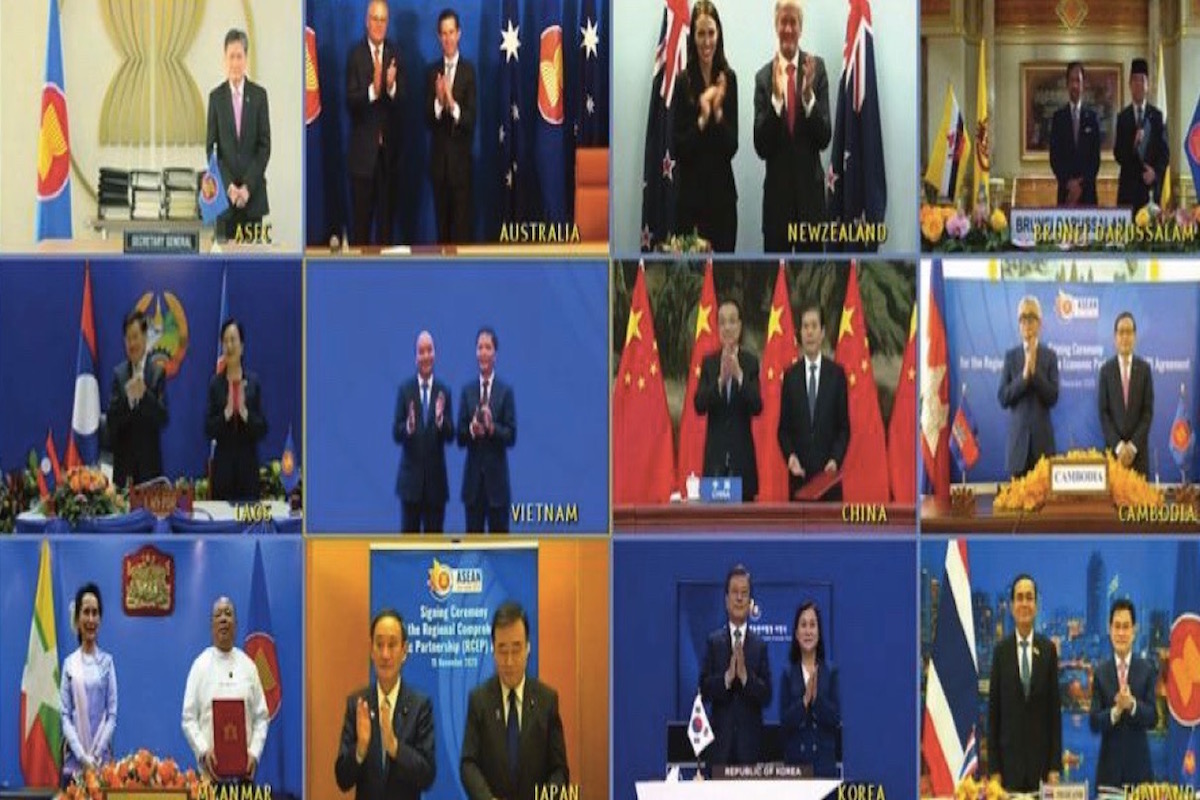Modi discusses trade deal with UK PM Sunak
During the discussion, the two leaders are understood to have discussed the broad contours of the proposed Free Trade Agreement between their two countries.
RCEP is relevant as Washington is gradually losing its economic ground in the Asia-Pacific region following its withdrawal from the Trans-Pacific Partnership (TPP) in 2017. The TPP was devised during President Barack Obama’s administration to counter China’s growing economic clout in the region. The

The Regional Comprehensive Economic Partnership (RCEP) trade deal was signed on 15 November 2020 via a videoconference by leaders of Australia, China, Japan, New Zealand, South Korea, and all the ten Asean member countries.
The deal effectuates a regional multilateral free trade agreement involving Beijing’s existing trade partners as well as close allies of the United States (US) such as Japan and South Korea. This is an indication of China’s growing power, and among others, the deal will bolster Beijing’s economic dominance in the AsiaPacific region. RCEP creates the most populous trade zone with a combined GDP of US$26.2 trillion, which is equivalent to 30 per cent of the total world economic output. The trading bloc embodies an overall population of 2.2 billion people.
Advertisement
Given its significance and potential global ramification, it is crucial for the US to maintain some influence in order to ensure stability and political balance in the region. It is also critical for the US to have stronger ties with its allies in the region because in the long run, this will shape how countries and governments look at issues related to environmental protection, labour laws and human rights.
Advertisement
RCEP essentially provides for reduction or elimination of tariffs on goods and services to be manufactured, transported, and sold in member states. Once the deal is implemented, the partnership will curve out a seamless supply chain throughout the trade zone.
This will be possible due to the pact’s rules of origin provisions that will set a criteria for how much goods can be produced in the bloc for the final product to ultimately qualify for concession. After that is ascertained, companies will be able to swiftly buy and sell products with one certificate of origin across the region.
China will largely benefit from this arrangement as the deal will proliferate its economic base by bringing together the Northeast and Southeast Asian countries under its orbit. Production and export will significantly improve once the pact is fully functional.
RCEP is relevant as Washington is gradually losing its economic ground in the Asia-Pacific region following its withdrawal from the Trans-Pacific Partnership (TPP) in 2017. The TPP was devised during President Barack Obama’s administration to counter China’s growing economic clout in the region. The TPP had comprehensive provisions on environment, intellectual property, labour regulations and human rights norms which would have challenged China’s business practices and instigated its neighbors to join hands for a more flexible and structured trade system.
When President Donald Trump pulled out of the multilateral trade deal, China saw it as an opportunity to fill the gap. It rigorously started campaigning and endorsing the RCEP. The present agreement does not comprise the same standards that were envisaged in the TPP, and at the moment, the US does not seem to carry much command over policies related to free trade in the Asia-Pacific region.
The actions of the world’s two greatest economies have somehow resulted in two things. First, it sends a major signal to investors and companies around the world that China and its Southeast Asian allies are strongly committed to multilateral trade and ease of doing business in the region. Second, even though there may be political differences between the US and China, allies of the US are willing to condone it for economic progress and infrastructure development in the region.
This speaks volumes about China’s increasing clout amongst its Asia-Pacific counterparts. It is interesting to see this development, especially given the fact that Beijing has been heavily criticised for its mishandling of information during the initial outbreak of Covid-19, as well as the criticism of its nonchalant attitude toward rule of law and the rights of other states at the international level. Moreover, RCEP will make it difficult for the US to regain its strong foothold in the region and correspondingly onerous to push for free and fair-trade norms that include international obligations of all nation states with respect to environmental protection, human rights and labour regulations.
Although there have been some reactions from the US, there is no immediate action plan as to how Washington will respond to it. Presidentelect Joe Biden spoke at a news conference in Wilmington, Delaware on 16 November 2020, where he stated that there is an urgent need for the US to deliberate and negotiate with its allies in the Asia-Pacific to reset the terms of global trading in order to combat China’s supremacy in the bloc.
But Biden has remained silent on whether he intends to rejoin the Comprehensive and Progressive Agreement for Trans-Pacific Partnership or join RCEP in the future.
It will, therefore, be crucial to observe the approach that will be adopted by the new administration in the coming months. In this regard, it is important that the Biden administration reconciles with its allies and proves that Washington is committed to trade deals.
The US can also persuade India, which was initially part of the RCEP negotiations but later decided to withdraw, to keep a check on China’s dominance in the region by possibly striking an alternative deal with Asean member states and other trade partners in the region.
Therefore, to restore economic and political equilibrium in the region, the US must act in consonance with its allies.
The writers are, respectively, Executive Director at the Center for Southeast Asian Studies (CSEAS), Jindal School of International Affairs, O.P. Jindal Global University and a fourth-year law student at Jindal Global Law School.
Advertisement